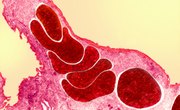Diffusion is the movement of molecules from areas where they're highly concentrated to less-concentrated areas. Diffusion takes place throughout the bodies of humans and other organisms, and is crucial to many of the metabolic processes that allow us to live our lives and stay healthy. The molecules that move during diffusion can be solids or gases, nutrients or wastes. Many organs, such as the lungs and small intestine, can be observed to find examples of diffusion.
Diffusion and Osmosis
One of the most important things to note when studying diffusion is the difference between diffusion and osmosis. These two terms are often confused for one another, for good reason: osmosis is actually a type of diffusion, specific to the movement of water and molecules soluble in water. While diffusion as a whole can transport any type of molecule, osmosis only occurs when water is diffused through a cell membrane as it moves from a high-concentration area to an area of lower concentration.
Respiration In The Lungs
Respiration is an example of diffusing gas molecules that takes places in the lungs. The oxygen we inhale is exchanged for carbon dioxide in tiny air sacs in the lungs. Oxygen-depleted blood goes near the lungs, and carbon dioxide diffuses into the air sacs where it is eventually removed through exhalation. At the same time, oxygen diffuses from the lungs into the bloodstream. After it diffuses into the bloodstream, it is picked up by blood cells. These blood cells move the oxygen across the body where it diffuses into other cells requiring oxygen. If this respiration cannot occur, cells will use anaerobic respiration to perform tasks. However, because this process can damage cells, lung failure can lead to serious damage to the body, or even death if too many brain cells are damaged in the process.
Neuron Communication in the Brain
Though we don't often think of them as cells that perform tasks like diffusion, neurons (commonly referred to as "brain cells") diffuse ions across their membranes as part of a larger communication network in the central nervous system. They send electrical signals by the diffusion of ions across their cell membranes. This releases an electric charge that flows from one cell to the next until it reaches the brain. The cell maintains a negative electric charge by controlling which ions go in and out of the membrane. Electric flow between neurons allows the brain to receive and process information about sensations we experience, such as physical pain and touching things in our environment, and send signals to various parts of our bodies to keep us moving and functioning.
Diffusion and Osmosis in the Kidney
The kidneys help maintain levels of molecules that the blood needs or doesn't need through diffusion with its membranes. For example, the kidney can move sodium into the blood when levels are low. They also take urea, a waste molecule, from the blood into their cells, which have a lower concentration of urea. At the same time, osmosis in the kidney allows this urea to be removed from the body through the process of urination. Dialysis, which is the artificial regulation of kidneys with a machine, also relies on membranes to regulate the levels of ions and other compounds that pass through the kidneys.
Diffusion In The Intestine
Diffusion also happens in the intestine after the food we ingest has been completely broken down to extract nutrients. Specialized cells in the small intestine take up these nutrients. Sometimes the nutrients are too large to be absorbed directly by the cell membrane, so they have to be swallowed up by the whole cell. After these intestinal cells absorb the nutrients, they transfer them to blood cells in vessels on the other side on the membrane. Blood cells take up the nutrients and carry them to various parts of the body.
Related Articles
References
Resources
Writer Bio
Scott has a biochemistry degree from UCSB with research experience and has a passion for science as well as writing. He has previously written for YoDerm, a dermatology-related start-up as a copywriter writing on various acne-related topics, drawing from his experience in biology and research.











